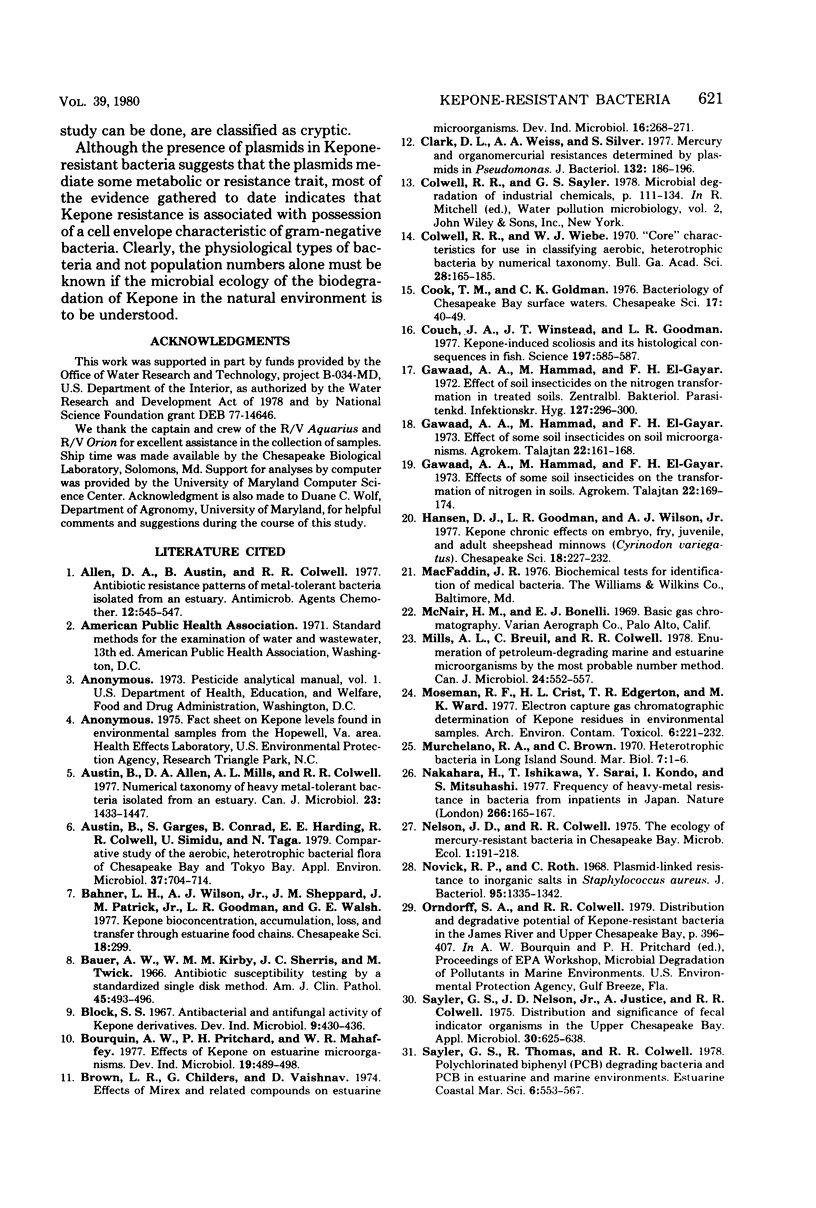Abstract
Effects of the chlorinated insecticide Kepone on the ecology of Chesapeake Bay and James River bacteria were studied. Kepone-resistant bacteria present in a given environment were found to reflect the degree of fecal and/or high organic pollution of the sampling sites, based on total numbers and generic composition of the populations of Kepone-resistant bacteria. The presence of Kepone-resistant bacteria was found to be correlated (α = 0.01) with total coliforms, fecal coliforms, and total aerobic viable heterotrophic bacteria, but not with Kepone concentration, since Kepone-resistant bacteria were present in locations where Kepone could not be detected by the analytical methods used in this study. Only gram-negative bacteria, predominantly Pseudomonas, Vibrio, and Aeromonas spp., were found to be resistant to ≥10 μg of Kepone per ml. Gram-positive bacteria, i.e., Bacillus and Corynebacterium spp., were generally sensitive to ≥0.1 μg of Kepone per ml. From results of cluster analysis of taxonomic data, we determined that characteristics of Kepone-resistant bacteria included: resistance to pesticides and heavy metals; degradation of oil; positive oxidase and catalase reactions; and nitrate reduction. From results of the ecological and taxonomic analyses, we conclude that Kepone resistance in estuarine bacteria is due to the physicochemical composition of the gram-negative cell wall and not prior exposure to Kepone. Therefore, the presence of Kepone-resistant bacteria cannot serve as an indicator of Kepone contamination in the aquatic environment where gram-negative bacteria are predominant.
Full text
PDF











Selected References
These references are in PubMed. This may not be the complete list of references from this article.
- Allen D. A., Austin B., Colwell R. R. Antibiotic resistance patterns of metal-tolerant bacteria isolated from an estuary. Antimicrob Agents Chemother. 1977 Oct;12(4):545–547. doi: 10.1128/aac.12.4.545. [DOI] [PMC free article] [PubMed] [Google Scholar]
- Austin B., Allen D. A., Mills A. L., Colwell R. R. Numerical taxonomy of heavy metal-tolerant bacteria isolated from an estuary. Can J Microbiol. 1977 Oct;23(10):1433–1447. doi: 10.1139/m77-212. [DOI] [PubMed] [Google Scholar]
- Austin B., Garges S., Conrad B., Harding E. E., Colwell R. R., Simidu U., Taga N. Comparative study of the aerobic, heterotrophic bacterial flora of Chesapeake Bay and Tokyo Bay. Appl Environ Microbiol. 1979 Apr;37(4):704–714. doi: 10.1128/aem.37.4.704-714.1979. [DOI] [PMC free article] [PubMed] [Google Scholar]
- Bauer A. W., Kirby W. M., Sherris J. C., Turck M. Antibiotic susceptibility testing by a standardized single disk method. Am J Clin Pathol. 1966 Apr;45(4):493–496. [PubMed] [Google Scholar]
- Clark D. L., Weiss A. A., Silver S. Mercury and organomercurial resistances determined by plasmids in Pseudomonas. J Bacteriol. 1977 Oct;132(1):186–196. doi: 10.1128/jb.132.1.186-196.1977. [DOI] [PMC free article] [PubMed] [Google Scholar]
- Couch J. A., Winstead J. T., Goodman L. R. Kepone-induced scoliosis and its histological consequences in fish. Science. 1977 Aug 5;197(4303):585–587. doi: 10.1126/science.69318. [DOI] [PubMed] [Google Scholar]
- Gawand A. A., Hammad M., el-Gayar F. H. Studies on soil insecticides. XI. Effect of some soil insecticides on the nitrogen transformation in treated soils. Zentralbl Bakteriol Parasitenkd Infektionskr Hyg. 1972;127(3):296–300. [PubMed] [Google Scholar]
- Moseman R. F., Crist H. L., Edgerton T. R., Ward M. K. Electron capture gas chromatographic determination of Kepone residues in environmental samples. Arch Environ Contam Toxicol. 1977;6(2-3):221–231. doi: 10.1007/BF02097763. [DOI] [PubMed] [Google Scholar]
- Nakahara H., Ishikawa T., Sarai Y., Kondo I. Frequency of heavy-metal resistance in bacteria from inpatients in Japan. Nature. 1977 Mar 10;266(5598):165–167. doi: 10.1038/266165a0. [DOI] [PubMed] [Google Scholar]
- Novick R. P., Roth C. Plasmid-linked resistance to inorganic salts in Staphylococcus aureus. J Bacteriol. 1968 Apr;95(4):1335–1342. doi: 10.1128/jb.95.4.1335-1342.1968. [DOI] [PMC free article] [PubMed] [Google Scholar]
- Sayler G. S., Nelson J. D., Jr, Justice A., Colwell R. R. Distribution and significance of fecal indicator organisms in the Upper Chesapeake Bay. Appl Microbiol. 1975 Oct;30(4):625–638. doi: 10.1128/am.30.4.625-638.1975. [DOI] [PMC free article] [PubMed] [Google Scholar]
- Sizemore R. K., Colwell R. R. Plasmids carried by antibiotic-resistant marine bacteria. Antimicrob Agents Chemother. 1977 Sep;12(3):373–382. doi: 10.1128/aac.12.3.373. [DOI] [PMC free article] [PubMed] [Google Scholar]
- Summers A. O., Jacoby G. A. Plasmid-determined resistance to boron and chromium compounds in Pseudomonas aeruginosa. Antimicrob Agents Chemother. 1978 Apr;13(4):637–640. doi: 10.1128/aac.13.4.637. [DOI] [PMC free article] [PubMed] [Google Scholar]
- Trudgill P. W., Widdus R., Rees J. S. Effects of organochlorine insecticides on bacterial growth, respiration and viability. J Gen Microbiol. 1971 Nov;69(1):1–13. doi: 10.1099/00221287-69-1-1. [DOI] [PubMed] [Google Scholar]
- Walker J. D., Colwell R. R. Mercury-resistant bacteria and petroleum degradation. Appl Microbiol. 1974 Jan;27(1):285–287. doi: 10.1128/am.27.1.285-287.1974. [DOI] [PMC free article] [PubMed] [Google Scholar]


